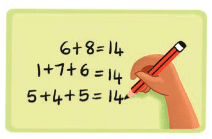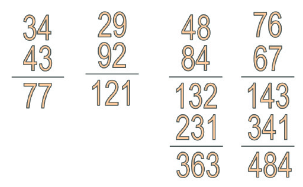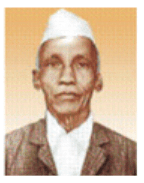Number Play Chapter Notes | Chapter Notes For Class 6 PDF Download
Introduction
Numbers play a vital role in our daily lives, helping us organise and manage various tasks. We use them for counting and performing basic operations like addition, subtraction, multiplication, and division to solve everyday problems. 
Examples of Situations Where We Use Numbers:
- Telling Time: We use numbers to read the time on a clock.
- Shopping: Numbers help calculate the total cost of items and manage money.
- Cooking: Recipes require specific measurements of ingredients, which involve numbers.
- Traveling: Numbers help us understand distances, speed, and time during travel.
- Sports: Scores, time limits, and player statistics all involve numbers.
Numbers Can Tell Us Things
Imagine a scenario where students are lined up for a school race. Each student announces a number, which represents something about their position in the line.
Let’s figure out what these numbers might mean:
- A student says ‘1’ if there is one faster runner next to them.
- A student says ‘2’ if both students next to them are faster.
- A student says ‘0’ if neither of the students next to them is faster.
In this case, each student counts how many of their neighbours are faster runners.
Supercell
A supercell is a number in a grid that is larger than all of its neighbouring numbers. The neighbours of a cell are the numbers directly to the left, right, above, and below it. Let’s say we have a grid of numbers, and our task is to find the supercells.
Example: Imagine a grid with the numbers 45, 78, 92, 31, and 60 arranged in a row. 92 would be a supercell if it is greater than 78 (to its left) and 31 (to its right).
92 would be a supercell if it is greater than 78 (to its left) and 31 (to its right).
Patterns of Numbers on the Number Line
Let’s practise placing some numbers on a number line. Imagine you have the following numbers: 2180, 2754, 1500, 3600, 9950, 9590, 1050, 3050, 5030, 5300, and 8400. These numbers need to be positioned correctly on the number line.
Here’s a basic number line to help you visualise:
- 2180 would be placed slightly after 2000 but before 3000.
- 9950 would be very close to 10,000.
- 3050 would be just after 3000, and so on.
Playing with Digits
When we start counting numbers, we write them in order: 1, 2, 3, and so on. Let’s explore how many numbers exist with different digit lengths.
1-digit numbers: These are the numbers from 1 to 9, so there are 9 one-digit numbers.
2-digit numbers: These numbers range from 10 to 99. To find out how many there are:
- Subtract the smallest two-digit number (10) from the largest (99) and add 1.
- 99 - 10 + 1 = 90
- So, there are 90 two-digit numbers.
3-digit numbers: These numbers range from 100 to 999.
- 999 - 100 + 1 = 900
- So, there are 900 three-digit numbers.
4-digit numbers: These numbers range from 1000 to 9999.
- 9999 - 1000 + 1 = 9000
- So, there are 9000 four-digit numbers.
5-digit numbers: These numbers range from 10,000 to 99,999.
- 99,999 - 10,000 + 1 = 90,000
- So, there are 90,000 five-digit numbers.
Digit Sums of Numbers
Rajat noticed an interesting pattern: sometimes, when you add the digits of different numbers, the sums are the same.
For example:
- 68: 6 + 8 = 14
- 176: 1 + 7 + 6 = 14
- 545: 5 + 4 + 5 = 14
All of these numbers have a digit sum of 14!
Digit Detectives
Mahi had a curious thought: how often does the digit ‘7’ appear when writing all the numbers from 1 to 100 or even 1 to 1000?
1 to 100: The digit ‘7’ appears in the 7th, 17th, 27th, 37th, 47th, 57th, 67th, 70–79 (10 times), and 87th, 97th. This totals 20 times.

- 1 to 1000: The digit ‘7’ appears more frequently in three positions (hundreds, tens, and units) across all numbers from 1 to 1000. Calculating this involves counting how often ‘7’ appears in each digit place:
- Units place: 100 times (7, 17, 27 … 997)
- Tens place: 100 times (70–79 in each hundred)
- Hundreds place: 100 times (700–799)
- So, the digit ‘7’ appears 300 times between 1 and 1000.
Pretty Palindromic Patterns
Palindromic numbers are numbers that read the same forward and backward. For example, numbers like 66, 848, 575, 797, and 1111 are all palindromes because they look the same whether you read them from left to right or right to left.
Creating 3-Digit Palindromes
Let’s explore how to create all possible 3-digit palindromes using the digits 1, 2, and 3. A 3-digit palindrome has the same first and third digits. Here’s how they look:
- 121: The first and last digits are 1, and the middle digit is 2.
- 131: The first and last digits are 1, and the middle digit is 3.
- 212: The first and last digits are 2, and the middle digit is 1.
- 232: The first and last digits are 2, and the middle digit is 3.
- 313: The first and last digits are 3, and the middle digit is 1.
- 323: The first and last digits are 3, and the middle digit is 2.

These are all possible 3-digit palindromes you can create using only the digits 1, 2, and 3.
Reverse-and-Add Palindromes
Now, let’s explore a fun activity involving palindromes, called the Reverse-and-Add method. Here’s how it works:
Start with a 2-digit number. For example, let’s pick 34.
Reverse the digits of the number: 34 becomes 43.
Add the original number to its reverse: 34 + 43 = 77.
Check if the result is a palindrome. If it is, you’re done. If not, reverse the new number and add again.
Let’s try another example with a different number, 47:
- Reverse 47 to get 74.
- Add them: 47 + 74 = 121.
- Since 121 is a palindrome, we stop here.

Let’s try with 89:
- Reverse 89 to get 98.
- Add them: 89 + 98 = 187 (not a palindrome, so continue).
- Reverse 187 to get 781.
- Add them: 187 + 781 = 968 (not a palindrome, so continue).
- Reverse 968 to get 869.
- Add them: 968 + 869 = 1837 (still not a palindrome).
In this case, you would keep repeating the process until you get a palindrome. Some numbers take several steps to become a palindrome, while others might never reach one!
The Magic Number of Kaprekar
D.R. Kaprekar was a mathematics teacher from Devlali, Maharashtra, who had a deep love for numbers. He discovered many interesting number patterns that had never been seen before. One of his most famous discoveries is the Kaprekar constant, a magical number associated with 4-digit numbers. 
Steps to Discover the Magic:
Pick any 4-digit number (e.g., 6382).
Arrange the digits to form the largest possible number. Call this A.
- For 6382, the largest number is 8632.
Rearrange the digits to form the smallest possible number. Call this B.
- For 6382, the smallest number is 2368.
Subtract B from A to get a new number, C.
- Subtract: 8632 - 2368 = 6264.

What Happens Next?
Take the number C and repeat the process:
Start with 6264:
- Largest number (A): 6642
- Smallest number (B): 2466
- Subtract: 6642 - 2466 = 4176
Continue with 4176:
- Largest number (A): 7641
- Smallest number (B): 1467
- Subtract: 7641 - 1467 = 6174
No matter which 4-digit number you start with, if you repeat these steps, you will always eventually reach the number 6174. This number is called the Kaprekar constant.
What About 3-Digit Numbers?If you carry out the same steps with 3-digit numbers, you will find that the number 495 keeps repeating. This is the Kaprekar constant for 3-digit numbers.
Clock and Calendar Numbers
Clocks and calendars aren’t just tools to tell time or date; they also have interesting numerical patterns hidden within.
Clock Patterns
A 12-hour clock shows interesting patterns in time.
For example:
- 4:44: All digits are identical.
- 10:10: The digits repeat in a mirrored fashion.
- 12:21: The time is palindromic, reading the same forward and backward.

Finding Other Patterns
- 1:11: All digits are the same.
- 2:22: Another example of identical digits.
- 3:33: Continuing the repetition pattern.
- 5:55: Following the same format.
- 11:11: A time noted for its symmetry.
In addition to these, you can also find other interesting patterns like:
- 12:12: Hour and minute digits repeat the same number.
- 2:20: The hour digit and the first digit of the minutes match.
- 5:05: The hour digit and the last digit of the minutes are the same.
These patterns show how even checking time can reveal hidden numerical beauty.
Calendar Patterns
Certain dates stand out because of how their digits repeat or follow sequences. For example, 20/12/2012 is interesting because the digits 2, 0, 1, and 2 repeat.
This kind of pattern can be found in other dates as well:
- 02/10/2001: The digits 2, 0, 1 repeat, but in a different order.
- 12/02/2001: A similar repeating pattern is seen.
- 10/02/2010: The digits 1, 0, 2, and 0 appear.
These dates catch attention because of their symmetry or repetition, making them memorable.
Palindromic Dates Like 11/02/2011
Palindromic dates are special because they read the same forwards and backwards.
Examples include:
- 02/02/2020: This date is a full palindrome.
- 11/02/2011: All digits are identical, and the entire date is a palindrome.
- 21/02/2012: Another palindromic date with a different sequence.
These dates are rare and often seen as lucky due to their symmetry.
Reusing Calendars
Jeevan’s curiosity about reusing calendars is a great question. While we typically need a new calendar each year, certain years can share the exact same calendar. This happens when the days of the week fall on the same dates, which depends on factors including whether it’s a leap year.
A leap year happens every 4 years to keep our calendar in sync with Earth's orbit around the Sun. For example, the year 2024 is a leap year, so February has 29 days instead of 28.
Mental Math
The numbers in the middle column are combined to create the numbers on the sides. You can use the middle numbers multiple times if needed.
Examples: 38,800
- Calculation: 25,000 + 400 × 2 + 13,000.
- Breakdown: Start with 25,000, add 800 (400 twice), then add 13,000.
Adding and Subtracting
Example: 39,800
- Calculation: 40,000 – 800 + 300 + 300.

- Breakdown: Start with 40,000, subtract 800, then add 300 twice.
Digits and Operations
Here are two examples:
- Adding Two 5-Digit Numbers: 12,350 + 24,545 = 36,895
- Subtracting Two 5-Digit Numbers: 48,952 − 24,547 = 24,405
Playing with Number Patterns
When numbers are arranged in patterns, there are often quicker ways to sum them rather than adding each number individually. Recognising patterns can simplify calculations.
From the Book
In these images, numbers are arranged in different patterns. The task is to find the sum of the numbers in each pattern. Instead of adding one by one, we can use tricks to find the sum faster.
Pattern a:
- Numbers Involved: 40 and 50
- Quick Calculation: Notice 50 is in the centre surrounded by 40s. Add by grouping or using multiplication for speed.
- Solution:
Step 1: Counting the numbers
There are 10 "50s" and 12 "40s".
Step 2: Multiply
10 × 50 = 500
12 × 40 = 480
Step 3: Add
500 + 480 = 980
Final Answer: 980.
Pattern b:
- Pattern Involved: Small squares filled with dots
- Quick Calculation: Count squares and multiply by dots per square for a quick total.
- Solution:
Step 1: Count squares — 64 total.
Step 2: Identify types:
44 squares with 1 dot each.
20 squares with 5 dots each.
Step 3: Multiply and sum:
44 × 1 = 44
20 × 5 = 100
Step 4: Add
44 + 100 = 144
Final Answer: 144 dots.
Pattern c:
- Numbers Involved: 32 and 64
- Quick Calculation: Multiply counts of 32s and 64s separately and add.
- Solution:
Step 1: Count numbers: 32 "32s" and 16 "64s".
Step 2: Multiply:
32 × 32 = 1024
16 × 64 = 1024
Step 3: Add
1024 + 1024 = 2048
Final Answer: 2048
Pattern d:
- Numbers Involved: More squares with dots
- Quick Calculation: Count squares and multiply, noting colour groups.
- Solution:
Step 1: Identify squares:
Purple and red squares having 4 dots and 3 dots.Step 2: Count squares:
17 squares have 3 dots
18 squares have 4 dotsStep 3: Multiply dots:
17 × 3 = 51
18 × 4 = 72Step 4: Add
51 + 72 = 123Final Answer: 123 dots.
Pattern e:
- Numbers Involved: 15, 25, and 35
- Quick Calculation: Group same numbers and multiply by their frequency.
- Solution:
Step 1: Identify numbers: 15, 25, 35.
Step 2: Count occurrences:
15 appears 14 times.
25 appears 14 times.
35 appears 14 times.
Step 3: Multiply:
15 × 14 = 210
25 × 14 = 350
35 × 14 = 490
Step 4: Add
210 + 350 + 490 = 1050
Final Answer: 1050.
Pattern f:
- Numbers Involved: 125, 250, 500, 1000
- Quick Calculation: Sum by adding outer circles inward.
- Solution:
Step 1: Numbers involved: 125, 250, 500, 1000.
Step 2: Count:
125 appears 18 times.
250 appears 8 times.
500 appears 4 times.
1000 appears once.
Step 3: Multiply:
125 × 18 = 2250
250 × 8 = 2000
500 × 4 = 2000
1000 × 1 = 1000
Step 4: Add
2250 + 2000 + 2000 + 1000 = 7250
Final Answer: 7250.
An Unsolved Mystery – the Collatz Conjecture
The Collatz Conjecture is an intriguing, unsolved mathematical sequence. Here's how it works:
Sequence Examples:
- Sequence a: 12, 6, 3, 10, 5, 16, 8, 4, 2, 1
- Sequence b: 17, 52, 26, 13, 40, 20, 10, 5, 16, 8, 4, 2, 1
- Sequence c: 21, 64, 32, 16, 8, 4, 2, 1
- Sequence d: 22, 11, 34, 17, 52, 26, 13, 40, 20, 10, 5, 16, 8, 4, 2, 1
Rules Applied:
- Even Number: Divide by 2.
- Odd Number: Multiply by 3 and add 1.
- Repeat: Continue applying these rules to the result.
Each sequence, no matter what number you start with, eventually reaches 1. This observation is central to the Collatz Conjecture.
Simple Estimation
Estimation helps when you do not need the exact number and want a quick idea. For example, estimating the number of books in a library by guessing based on what you see instead of counting each book.
Example 1: Estimating the Number of Books in a Library
- There are about 300 books on each shelf.
- There are 10 shelves in the library.
- Estimate: Multiply 300 by 10 to estimate around 3,000 books.
Example 2: Estimating Guests at a Party
- Each table has about 8 people.
- There are 12 tables.
- Estimate: Multiply 8 by 12 to estimate about 100 people.
FAQs on Number Play Chapter Notes - Chapter Notes For Class 6
| 1. What are some interesting patterns we can find on the number line? |  |
| 2. What makes a number a palindrome? |  |
| 3. What is the magic number of Kaprekar? |  |
| 4. How can we use mental math to solve problems quickly? |  |
| 5. What are clock and calendar numbers, and how do they relate to patterns? |  |






















